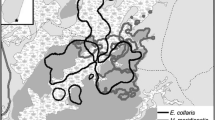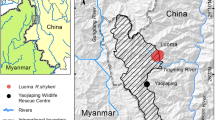Abstract
A key aspect of a primate’s ecology is its food source, the very nature of which is spatially and seasonally dependent and may be affected by anthropic pressures. One of the most endangered, yet best-studied, strepsirrhine primates is the ring-tailed lemur (Lemur catta), a species that has experienced significant human-induced habitat loss over many decades. To help understand feeding variability across time and space, I present a literature review of plant species (and parts) fed on by ring-tailed lemurs at nine sites in Madagascar: Ambatotsirongorongo, Andringitra Massif, Anja Reserve, Antserananomby, Berenty Reserve, Bezà Mahafaly Special Reserve, Cap Sainte-Marie, Tsaranoro Valley Forest, and Tsimanampetsotsa National Park. I gathered literature using keyword searches on Google Scholar (https://scholar.google.com/) and verified scientific names using the “Catalogue of the Plants of Madagascar” (http://legacy.tropicos.org/Project/Madagascar). From 24 studies, I identify 221 genera and 241 species of consumed plants, with 92 genera and 70 species consumed at two or more sites. Based on the available distribution data, 63% of species are endemic and 22% native. Sixty-seven plants are known only by Malagasy common names and excluded from analyses. When authors identify the plant tissue consumed, 52% of species in the diet are represented by a single tissue type, typically leaves (mature and immature) or fruit (ripe or unripe). This review highlights the importance of studying multiple populations when creating dietary summaries of species and should prove valuable to those exploring ecological trends and habitat use by ring-tailed lemurs.


Similar content being viewed by others
References
Britt, A., Welch, C., & Katz, A. (1998). The first release of captive-bred lemurs into their natural habitat. Lemur News, 3, 8–11.
Britt, A., Welch, C., & Katz, A. (2004). Can small, isolated primate populations be effectively reinforced through the release of individuals from a captive population? Biological Conservation, 115, 319–327. https://doi.org/10.1016/S0006-3207(03)00150-2.
Cameron, A., & Gould, L. (2013). Fragment-adaptive behavioural strategies and intersite variation in the ring-tailed lemur (Lemur catta) in south-central Madagascar. In L. K. Marsh & C. A. Chapman (Eds.), Primates in fragments (pp. 227–243). New York: Springer Science+Business Media.
Chandrashekar, A., Knierim, J. A., Khan, S., Raboin, D. L., Venkatesh, S., et al (2020). Genetic population structure of endangered ring-tailed lemurs (Lemur catta) from nine sites in southern Madagascar. Ecology and Evolution. https://doi.org/10.1002/ece3.6337.
Crowley, B. E., Godfrey, L. R., Guilderson, T. P., Zermeno, P., Koch, P. L., & Dominy, N. J. (2012). Extinction and ecological retreat in a community of primates. Proceedings of the Royal Society of London B: Biological Sciences, 279, 3597–3605. https://doi.org/10.1098/rspb.2012.0727.
Cuozzo, F. P., & Sauther, M. L. (2006). Severe wear and tooth loss in wild ring-tailed lemurs (Lemur catta): A function of feeding ecology, dental structure, and individual life history. Journal of Human Evolution, 51, 490–505. https://doi.org/10.1016/j.jhevol.2006.07.001.
Cuozzo, F. P., & Sauther, M. L. (2015). Patterns of dental macrowear in subfossil Lemur catta from Ankilitelo Cave, Madagascar: Indications of ecology and habitat use over time. Folia Primatologica, 86, 140–149. https://doi.org/10.1159/000369900.
Gabriel, D. N. (2013). Ecological flexibility in a disturbed landscape: An assessment of the behavioural and health ecology of ring-tailed lemurs (Lemur catta) in relation to forest fragmentation. Doctoral dissertation, University of Victoria.
Gemmill, A., & Gould, L. (2008). Microhabitat variation and its effects on dietary composition and intragroup feeding interactions between adult female Lemur catta during the dry season at Beza Mahafaly Special Reserve, southwestern Madagascar. International Journal of Primatology, 29, 1511. https://doi.org/10.1007/s10764-008-9316-z.
Goodman, S. M., & Langrand, O. (1996). A high mountain population of the ring-tailed lemur Lemur catta on the Andringitra Massif, Madagascar. Oryx, 30, 259–268. https://doi.org/10.1017/S003060530002175X.
Goodman, S. M., Rakotoarisoa, S. V., & Wilmé, L. (2006). The distribution and biogeography of the ringtailed lemur (Lemur catta) in Madagascar. In A. J. Jolly, R. W. Sussman, N. Koyama, & H. Rasamimanana (Eds.), Ringtailed lemur biology (pp. 3–15). Developments in Primatology: Progress and Prospects. New York: Springer Science+Business Media.
Google Earth (n.d). Google Earth version 9.3.115.1. Available at https://www.google.com/earth/
Gould, L., & Cowen, L. L. (2020). Lemur catta in small forest fragments: Which variables best predict population viability? American Journal of Primatology, 82, e23095. https://doi.org/10.1002/ajp.23095.
Gould, L., & Gabriel, D. N. (2015). Wet and dry season diets of the Endangered Lemur catta (ring-tailed lemur) in two mountainous rocky outcrop forest fragments in south-central Madagascar. African Journal of Ecology, 53, 320–330. https://doi.org/10.1111/aje.12186.
Gould, L., Kelley, E. A., & LaFleur, M. (2015). Reproductive female feeding strategies in spiny forest-dwelling Lemur catta in southern and southwestern Madagascar: How do females meet the challenges of reproduction in this harsh habitat? Folia Primatologica, 86, 16–24. https://doi.org/10.1159/000369580.
Gould, L., Power, M. L., Ellwanger, N., & Rambeloarivony, H. (2011). Feeding behavior and nutrient intake in spiny forest-dwelling ring-tailed lemurs (Lemur catta) during early gestation and early to mid-lactation periods: Compensating in a harsh environment. American Journal of Physical Anthropology, 145, 469–479. https://doi.org/10.1002/ajpa.21530.
Gould, L., & Sauther, M. L. (2016). Going, going, gone… Is the iconic ring-tailed lemur (Lemur catta) headed for imminent extirpation. Primate Conservation, 30, 89–101.
Hemingway, C. A., & Bynum, N. (2005). The influence of seasonality on primate diet and ranging. In D. K. Brockman & C. P. van Schaik (Eds.), Seasonality in primates (pp. 57–104). New York: Cambridge University Press.
IUCN (2020). The IUCN Red List of Threatened Species. Version 2020-2. https://www.iucnredlist.org.
Kelley, E. (2011). Lemur catta in the region of Cap Sainte-Marie, Madagascar: Introduced cacti, xerophytic Didiereaceae-Euphorbia bush, and tombs. Doctoral dissertation, Washington University in St. Louis.
Kelley, E. A., Sussman, R. W., & Muldoon, K. M. (2007). The status of lemur species at Antserananomby: An update. Primate Conservation, 22, 71–77. https://doi.org/10.1896/052.022.0105.
Kremen, C., Cameron, A., Moilanen, A., Phillips, S. J., Thomas, C. D., et al (2008). Aligning conservation priorities across taxa in Madagascar with high-resolution planning tools. Science, 320, 222–226. https://doi.org/10.1126/science.1155193.
LaFleur, M. (2012). Ecology of ring-tailed lemurs (Lemur catta) at the Tsimanampetsotsa National Park, Madagascar: Implications for female dominance and the evolution of lemur traits. Doctoral dissertation, University of Colorado at Boulder.
LaFleur, M., Clarke, T. A., Reuter, K., & Schaeffer, T. (2016). Rapid decrease in populations of wild ring-tailed lemurs (Lemur catta) in Madagascar. Folia Primatologica, 87, 320–330. https://doi.org/10.1159/000455121.
LaFleur, M., & Gould, L. (2020). Lemur catta. The IUCN Red List of Threatened Species 2020: e.T11496A115565760. https://doi.org/10.2305/IUCN.UK.2020-2.RLTS.T11496A115565760.en.
LaFleur, M., & Sauther, M. L. (2015). Seasonal feeding ecology of ring-tailed lemurs: A comparison of spiny and gallery forest habitats. Folia Primatologica, 86, 25–34. https://doi.org/10.1159/000369581.
Madagascar Catalogue. Catalogue of the Plants of Madagascar. Missouri Botanical Garden, St. Louis, MO. http://www.tropicos.org/Project/Madagascar.
Pinkus, S., Smith, J. N., & Jolly, A. (2006). Feeding competition between introduced Eulemur fulvus and native Lemur catta during the birth season at Berenty Reserve, southern Madagascar. In A. J. Jolly, R. W. Sussman, N. Koyama, & H. Rasamimanana (Eds.), Ringtailed lemur biology (pp. 119–140). Developments in Primatology: Progress and Prospects. New York: Springer Science+Business Media.
Razafindramanana, J. (2011). Behavioural ecology of sympatric lemur species Lemur catta and Eulemur sp. in forest fragments, south-eastern Madagascar. Doctoral dissertation, Oxford Brookes University.
Sauther, M. L., & Cuozzo, F. P. (2009). The impact of fallback foods on wild ring-tailed lemur biology: A comparison of intact and anthropogenically disturbed habitats. American Journal of Physical Anthropology, 140, 671–686. https://doi.org/10.1002/ajpa.21128.
Schwitzer, C., Mittermeier, R. A., Johnson, S. E., Donati, G., Irwin, M., et al (2014). Averting lemur extinctions amid Madagascar's political crisis. Science, 343, 842–843. https://doi.org/10.1126/science.1245783.
Simmen, B., Hladik, A., & Ramasiarisoa, P. (2003). Food intake and dietary overlap in native Lemur catta and Propithecus verreauxi and introduced Eulemur fulvus at Berenty, Southern Madagascar. International Journal of Primatology, 24, 949–968. https://doi.org/10.1023/A:1026366309980.
Simmen, B., Sauther, M. L., Soma, T., Rasamimanana, H., Sussman, R. W., et al. (2006). Plant species fed on by Lemur catta in gallery forests of the southern domain of Madagascar. In A. J. Jolly, R. W. Sussman, N. Koyama, & H. Rasamimanana (Eds.), Ringtailed lemur biology (pp. 55–68). Developments in Primatology: Progress and Prospects. New York: Springer Science+Business Media.
Soma, T. (2006). Tradition and novelty: Lemur catta feeding strategy on introduced tree species at Berenty Reserve. In A. J. Jolly, R. W. Sussman, N. Koyama, & H. Rasamimanana (Eds.), Ringtailed lemur biology (pp. 141–159). Developments in Primatology: Progress and Prospects. New York: Springer Science+Business Media.
Sussman, R. W. (1974). Ecological distinctions in sympatric species of Lemur. In R. D. Martin, G. A. Doyle, & A. C. Walker (Eds.), Prosimian biology (pp. 75–108). London: Gerald Duckworth and Co..
van Schaik, C. P., & Kappeler, P. M. (1996). The social systems of gregarious lemurs: Lack of convergence with anthropoids due to evolutionary disequilibrium? Ethology, 102, 915–941.
Yamashita, N., Cuozzo, F. P., Sauther, M. L., Fitzgerald, E., Riemenschneider, A., & Ungar, P. S. (2016). Mechanical food properties and dental topography differentiate three populations of Lemur catta in southwest Madagascar. Journal of Human Evolution, 98, 66–75. https://doi.org/10.1016/j.jhevol.2015.09.006.
Acknowledgments
I would like to thank Dr. Ethan Rogers (St. Joseph Medical Center) and Dr. Siobhán Cooke (Johns Hopkins University School of Medicine) for providing guidance on the direction of this project as well as revising earlier drafts and Zana Sims (Johns Hopkins University School of Medicine) for assisting me with converting coordinates data. I am extremely grateful for the time and effort given to greatly improving this manuscript by the anonymous reviewers of the journal and to the editor-in-chief, Dr. Joanna Setchell.
Author information
Authors and Affiliations
Contributions
The author conceived, designed, and executed this study and wrote the manuscript. No other person is entitled to authorship.
Corresponding author
Additional information
Handling Editor: Joanna Setchell
Supplementary Information
ESM 1
(XLSX 37 kb)
Rights and permissions
About this article
Cite this article
Canington, S.L. Plant Species Fed on by Wild Ring-Tailed Lemurs (Lemur catta) at Nine Sites. Int J Primatol 42, 16–25 (2021). https://doi.org/10.1007/s10764-020-00184-1
Received:
Accepted:
Published:
Issue Date:
DOI: https://doi.org/10.1007/s10764-020-00184-1




